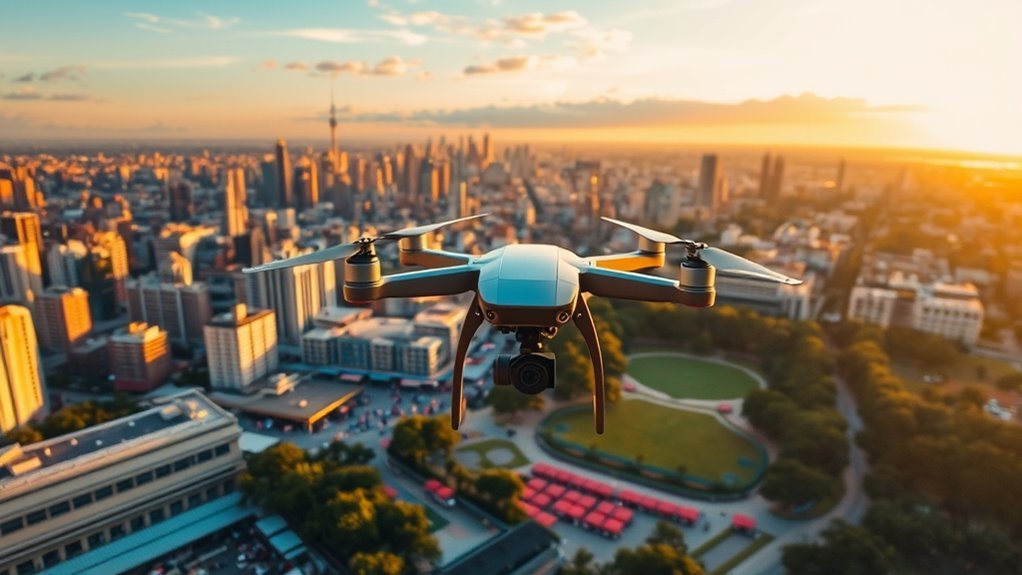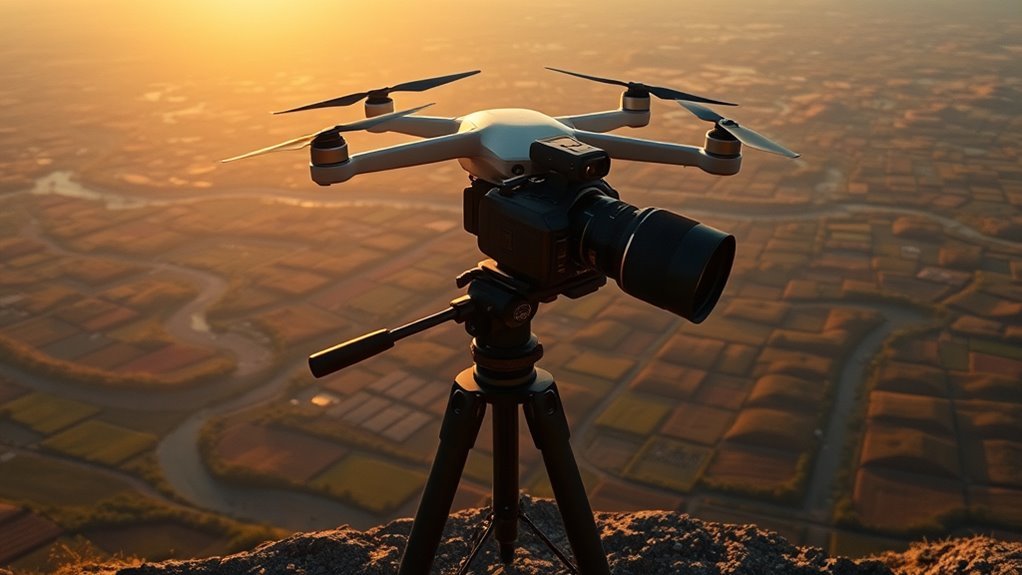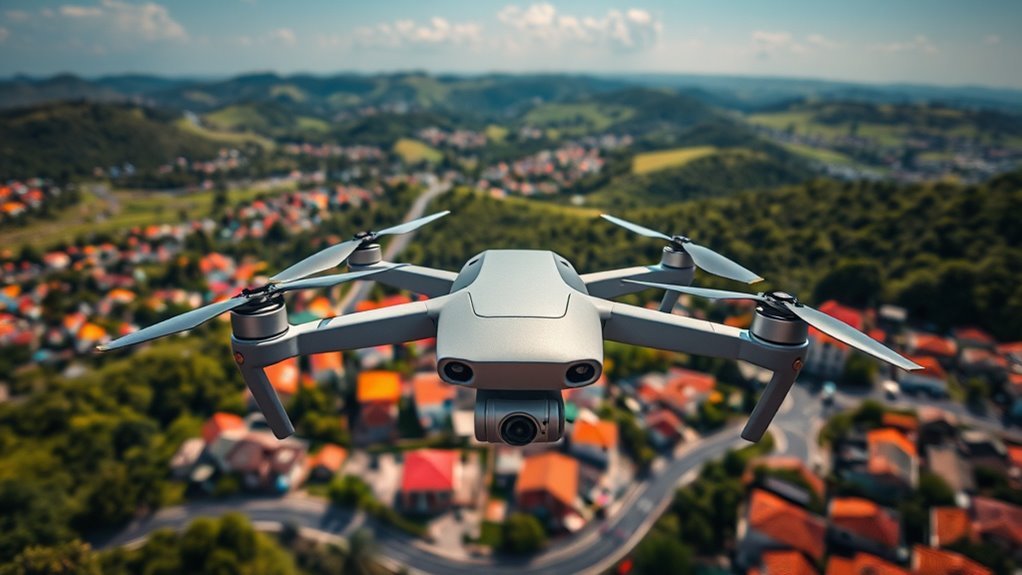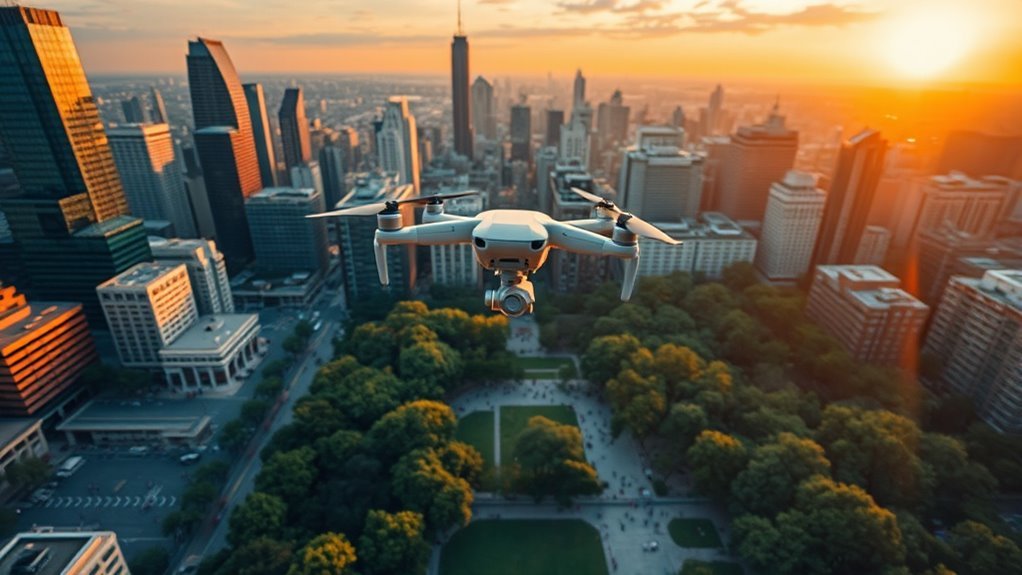As a drone photographer, you can make anywhere from a few hundred to several thousand dollars per project. Your income depends on factors like experience, the type of projects you pursue, and varying market demands. Urban areas often pay more, while niche opportunities in rural settings can bring unique rewards. Balancing glamorous gigs with stable work can enhance profitability. Curious about how to maximize your earnings and future trends in this exciting field? Let’s explore further!
Overview of Drone Photography Earnings

Diving into the world of drone photography can be both exhilarating and profitable. With the rise of emerging technologies, you’re stepping into a vibrant arena where creativity meets commerce. The drone photography markets are expanding rapidly, opening doors to diverse opportunities. Whether you’re capturing breathtaking landscapes, real estate showcases, or unforgettable events, you can carve out your niche and monetize your skills. Earnings can vary widely based on your expertise, location, and the demand within your chosen market. By harnessing the power of drones, you can offer unique perspectives that traditional photography simply can’t match. This freedom allows you to explore your artistic vision while building a sustainable income stream—an appealing prospect for any aspiring drone photographer.
Factors Influencing Income

When you’re considering your earnings as a drone photographer, several key factors come into play. Your experience level can greatly boost your income potential, while the geographic location can either open doors or present challenges. Plus, industry demand shapes the opportunities available, making it essential to stay ahead of trends in your market.
Experience Level
As you navigate the world of drone photography, your experience level can greatly shape your earnings, influencing everything from pricing strategies to client acquisition. If you’re just starting out, your beginner skills might limit your rates, but don’t underestimate the power of building a portfolio. As you hone advanced techniques, you’ll not only elevate your craft but also your income potential. Clients are drawn to photographers who can deliver stunning visuals and unique perspectives, so investing in your growth can pay off. Embrace workshops and hands-on projects to refine your skills, and watch your confidence—and earnings—soar. Ultimately, your journey reflects your commitment, and with each flight, you’re not just capturing images; you’re crafting a freedom-filled future.
Geographic Location
Your experience level might set the foundation for your earnings, but the geographic location where you operate can greatly impact your income potential. In urban markets, demand for drone photography often skyrockets, leading to higher pay. However, don’t overlook rural opportunities, where you might find less competition and unique projects. Here are some factors to evaluate:
- Cost of living in your area
- Local demand for drone services
- Number of competing photographers
- Accessibility of scenic locations
- Networking opportunities within the community
Industry Demand
While the geographic location plays a significant role in your earnings, the industry demand for drone photography is equally essential in determining your income potential. As drone technology evolves, the market growth for aerial imagery expands, creating countless opportunities for creatives like you. Industries such as real estate, tourism, and construction increasingly seek stunning aerial shots to enhance their marketing strategies. Your ability to adapt to these trends can set you apart from the competition. By staying updated on the latest drone innovations and understanding client needs, you position yourself for success. Embrace this entrepreneurial spirit, and you’ll not only enjoy financial benefits but also the freedom to explore new horizons in your aerial photography career.
Experience Level and Its Impact

As you navigate the world of drone photography, your experience level will greatly shape your earnings. Entry-level photographers often find themselves on a tight budget, while those with advanced skills can command a premium for their unique perspective and expertise. Understanding this dynamic can help you strategize your growth and maximize your income potential in this booming field.
Entry-Level Earnings
Although entering the drone photography market can feel intimidating, the potential for earning a solid income is quite promising, even for beginners. With entry-level skills and beginner equipment, you can start carving out your niche. Here are some aspects to reflect upon for your journey:
- Market Demand: Real estate, events, and tourism are booming sectors needing aerial shots.
- Portfolio Building: Start with local gigs or volunteer projects to showcase your work.
- Networking Opportunities: Attend drone meetups or photography workshops to connect with potential clients.
- Pricing Strategy: Research local rates and set competitive prices for your services.
- Continuous Learning: Stay updated with new techniques and technology to enhance your skills.
With determination, you’ll be well on your way to success!
Advanced Experience Compensation
With five years of experience under your belt, you’ll likely see a significant boost in your drone photography earnings. Mastering advanced techniques not only enhances your portfolio but also sets you apart in a competitive market. Clients are willing to pay a premium for your expertise, especially when you showcase stunning aerial shots that tell a story.
Additionally, your equipment investment pays off; high-quality drones and cameras elevate your work, attracting higher-paying gigs. Whether you’re capturing breathtaking landscapes or dynamic real estate shots, your skills and gear reflect your professionalism. As you continue to refine your craft, you’ll enjoy the freedom to choose projects that resonate with you, ultimately leading to both financial rewards and personal satisfaction.
Geographic Variations in Pay
When you plunge into the world of drone photography, you’ll quickly notice that pay can vary considerably depending on where you set up shop. Regional disparities play a significant role in your location-based earnings. Urban areas often offer more opportunities, while rural locations might present unique challenges. Here’s what to take into account:
- Cost of Living: Higher in cities, impacting your pricing.
- Demand for Services: Tourist spots typically attract more clients.
- Local Competition: More photographers can mean lower rates.
- Industry Specialization: Real estate vs. events can change your pay scale.
- Networking Opportunities: Larger cities often foster more connections.
Understanding these factors will help you navigate the diverse landscape of drone photography compensation. Embrace the freedom of location, and choose wisely!
Types of Projects and Their Earnings
As you explore the diverse domain of drone photography, you’ll discover that the types of projects you take on can considerably influence your earnings. Wedding photography, for instance, not only allows you to capture breathtaking moments but often commands premium rates. Couples are willing to invest in stunning aerial shots that elevate their special day, potentially netting you thousands. On the flip side, aerial mapping projects can provide steady income, especially with industries like real estate and construction seeking precise topographical data. While these jobs may not have the glamor of weddings, their demand and regularity can offer you financial stability. By diversifying your portfolio, you can maximize your earnings and cultivate a rewarding career that aligns with your passion for freedom.
Average Salary Ranges
While the potential earnings in drone photography can vary widely, understanding average salary ranges can help you set realistic expectations and goals for your business. Here’s a snapshot of what you might earn:
- Entry-level: $30,000 – $50,000
- Mid-level: $50,000 – $80,000
- Experienced: $80,000 – $120,000
- Top professionals: $120,000+
- Freelancers: Earnings can fluctuate based on project volume and client acquisition strategies.
Mastering various drone photography techniques and honing your client acquisition strategies will play a significant role in boosting your income. With passion and dedication, you can pave your own path in this exhilarating field, enjoying both financial freedom and creative fulfillment.
Freelance vs. Full-Time Employment
The decision between freelancing and full-time employment in drone photography greatly impacts your earnings, work-life balance, and creative freedom. If you crave freelance flexibility, you can choose projects that ignite your passion, set your own hours, and explore diverse locations. However, this comes with the uncertainty of fluctuating income and the hustle of finding clients. On the other hand, full-time stability offers a predictable paycheck, benefits, and a structured routine, allowing you to hone your skills without the stress of constant self-promotion. Weighing these options depends on your lifestyle goals—do you prioritize creative exploration or the comfort of security? Ultimately, the choice shapes not just your career but how you envision your life as a drone photographer.
Tips for Increasing Your Income
To boost your income as a drone photographer, consider diversifying your skill set and services. Embracing new techniques not only enhances your portfolio but also attracts a broader clientele. Here are some marketing strategies and skill development tips to elevate your earnings:
- Offer packages: Create bundled services for real estate, weddings, or events.
- Upsell editing services: Provide professional post-processing to enhance your images.
- Network actively: Attend local events to meet potential clients and collaborators.
- Leverage social media: Share your work on platforms like Instagram to increase visibility.
- Learn new skills: Stay updated with drone technology and photography trends to remain competitive. Incorporating features like advanced obstacle avoidance can set your work apart and ensure safer flights. Additionally, mastering intelligent flight modes can enhance the creativity of your shots and provide unique perspectives that clients will appreciate.
These steps can help you open new avenues for income and enjoy the freedom you crave!
Future Trends in Drone Photography Earnings
As the drone photography industry evolves, you’ll find exciting opportunities emerging that could greatly impact your earnings. With emerging technologies like AI and enhanced imaging tools, you can elevate your work, offering clients stunning visuals that stand out. Market expansion in sectors like real estate and tourism means there’s a growing demand for your skills. You’ve got the chance to carve out your niche by adapting to these trends, whether it’s through specialized services or innovative packages. As drone regulations become more streamlined, your freedom to operate will increase, opening new avenues for income. Embrace these changes, stay ahead of the curve, and watch your earnings soar as you tap into this dynamic landscape. Additionally, innovations like AI integration are projected to significantly enhance the capabilities of drone photographers, making their work more appealing to clients. Furthermore, DJI’s commitment to research and development ensures that you will have access to cutting-edge tools and technologies that can elevate your photography services.
Frequently Asked Questions
What Certifications Are Required for Drone Photographers?
Like a bird soaring through the sky, you’ll need to navigate drone regulations for aerial photography. Certifications, such as the FAA Part 107,’ll grant you the freedom to capture breathtaking views legally and safely.
How Much Do Drone Photographers Charge per Hour?
When determining how much to charge per hour, consider your pricing strategies and the market demand. Tailor your rates to reflect your skills, the uniqueness of your work, and the freedom you offer clients.
Are There Any Specific Software Tools Needed for Editing Drone Photos?
So, you think you can just wing it with drone photos? Think again! For editing, you’ll need software like Adobe Lightroom and Photoshop. Mastering these tools and techniques is key to releasing your creative freedom!
What Types of Insurance Should Drone Photographers Consider?
As a drone photographer, you should consider liability coverage to protect against accidents or damages. Plus, equipment insurance safeguards your valuable gear. Investing in both guarantees you can fly freely without worrying about unexpected costs.
Can Drone Photographers Work in Multiple Industries Simultaneously?
Why limit yourself? As a drone photographer, you can thrive in multi industry projects, building a diverse client base. Embrace the freedom to explore various fields and capture stunning visuals that transcend boundaries.

